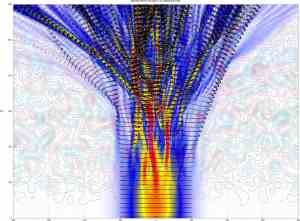
Our universe displays various mass concentrations of matter and is not a homogeneous density soup of particles as assumed in the simplest cosmological models where isotropy is assumed (cosmological principle). Interestingly recent supernova data (see Colin et al Evidence of anisotropy of cosmic acceleration A&A 631 L13, also on the arxiv) shows deviations of the angular distribution of matter as seen from Earth. One possibility (also not taken into account in the standard model) is the topology of the cosmos, discussed in this blog by Peter Kramer before. But back to the “small structures” (< 100 Mega parsec): How do mass concentrations arise and how get small fluctuations amplified?
One universal mechanism at work across many domains of physics is structure formation and concentration into branches by random weak scattering. The key-point is: despite randomness this type of scattering does not smear out the density as expected by diffusion processes. This important mechanism has been independently discovered in various domains of physics, but has been rarely discussed and further explored within a consistent framework. Interestingly the fundamental branching behavior can be seen in both quantum mechanics and classical physics. Together with Rick Heller and Ragnar Fleischmann we have written a short overview article (available on the arxiv: “Branched flow”) which provides some background information and serves as a starting point for further exploration. We also provide a short python script to generate intricate patterns out of random deformations (script available on github).

One example discussed in this blog is the formation of “dust concentrations” in the near nucleus coma of comets from a homogeneously emitting cometary surface. The structure formation of the universe (the cosmic web) is discussed by Y. Zeldovich and reviewed by P.J.E. Peebles in his monograph The Large-Scale Structure of the Universe (Princeton University Press, 1980) in the chapter “caustics and pancakes”. A more accessible incarnation of the caustics are the ripples of sunlight at a pool bottom.